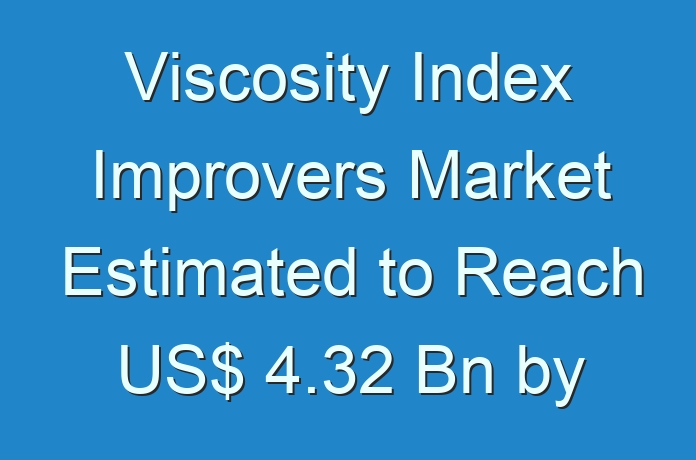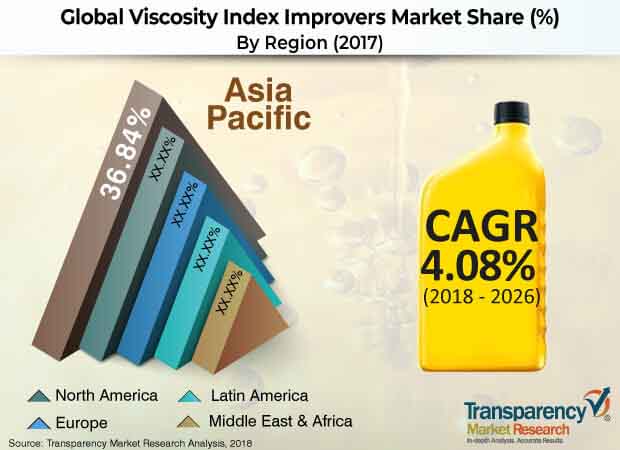
Viscosity Index Improvers Market – Snapshot
Lubricants are expected to deliver satisfactory performance at all conditions ranging from low to high temperatures, without undergoing drastic changes in their viscosity during the operation. In order to ensure this, lubricant manufacturers rely on viscosity index improvers to deliver optimal viscosity performance at all operating conditions. Viscosity can be described as inherent resistance of a liquid to flow, while viscosity index represents response of the liquid to changes in temperature (generally, from 40°C to 100°C). If a lubricant exhibits drastic change in viscosity over a range of temperature, the lubricant is said to have low viscosity index. Viscosity index improvers are polymers that are added to a lubricant in order to resist change in its viscosity with rise in the temperature. With increase in temperature, polymeric molecules of viscosity index improvers tend to stretch out, thereby increasing the internal friction of the fluid to the flow. With increase in internal friction, the fluid flows at a slower pace, thereby exhibiting increase in its viscosity. Viscosity index improvers can vary greatly, depending on their molecular structure and specific chemistry.

Request A Sample – https://www.transparencymarketresearch.com/sample/sample.php?flag=S&rep_id=35525
Increasing demand for lubricants and rising automotive sales likely to drive the market
Lubricants have become an essential part of the modern-day industry. Almost any type of operation or machining requires some sort of lubricants in order to enhance the overall efficiency of the operation. Lubricants are products that are used to reduce friction between two surfaces, thereby increasing the operational efficiency and providing wear protection to surfaces, which extends machine runtimes and prevents wear and tear of machine parts. A viscosity index improver is an essential part of every lubricant additive batch, as it helps the lubricant to maintain its viscosity when subjected to high operating temperatures. Thus, increase in the demand for lubricants is likely to drive the demand for viscosity index improvers during the forecast period. Rapid ongoing industrialization, especially in developing economies such as BRICS, is also expected to drive the market during the forecast period. Growth of sectors, such as industrial machinery, automotive, and energy, in these countries is boosting the demand for lubricants along with their additives such as viscosity index improvers.
Moreover, growth of the automotive sector is also projected to drive the market for viscosity index improvers during the forecast period. The automotive industry is one of the largest consumers of lubricants. This correlates the demand for base oils and lubricant additives with the automotive sector. Thus, increasing demand for automobiles and expanding automotive sector are likely to augment the viscosity index improver market in the near future.
More Trending Reports by Transparency Market Research – https://www.prnewswire.com/news-releases/increasing-demand-for-power-to-drive-global-underground-mining-market-to-valuation-of-us-25-bn-by-2027–transparency-market-research-301008293.html
Long engine oil drain interval expected to restrain the market
Ongoing technological advancements in the automotive industry have resulted in evolution of the engine technology and lubricant oil chemistry over the last few years. This development has improved the engine oil drain interval from an average of 25,000 miles to as high as 50,000 miles for a heavy-duty truck. Moreover, increasing usage of cleaner fuels, high-quality lubricants, dependable engines, and the superior filter technology has raised the average oil drain interval. This rise in the oil drain interval is likely to reduce the consumption of engine oils in automobiles. This, in turn, is likely to restrain the demand for viscosity index improvers during the forecast period.
Rising need for improvement in fuel economy to offer lucrative opportunities to the viscosity index improvers market
Increasing demand for improved fuel economy, reduction in emissions, and better durability has resulted in the upgrade of automobile hardware. Moreover, the trend necessitates improvement in the lubricant performance, thereby creating demand for viscosity index improvers and performance additives. Significant efforts are being made in this direction in order to improve the performance of viscosity index improvers, allowing blending of lubricants at high viscosity index so as to improve the fuel economy and reduce engine deposits. Therefore, rising need for improvement in the fuel economy is likely to provide lucrative opportunities to the viscosity index improver market during the forecast period.
Ask for Discount on Premium Research Report With Complete TOC at – https://www.transparencymarketresearch.com/sample/sample.php?flag=D&rep_id=35525
Asia Pacific held a major i.e. around 35% share of the global market in 2017
Based on region, the global viscosity index improver market has been divided into North America, Latin America, Europe, Asia Pacific, and Middle East & Africa. Asia Pacific dominated the global market in 2017. This can be primarily ascribed to the region being an automotive and industrial hub. Moreover, the market in Asia Pacific is anticipated to expand at a significant pace during the forecast period, primarily due to rise in the demand for automobiles in the region, especially in developing countries such as China and India.
Request for covid19 Impact Analysis – https://www.transparencymarketresearch.com/sample/sample.php?flag=covid19&rep_id=35525
A few large players dominate global viscosity index improver market
Key players operating in the global viscosity index improver market are Evonik Industries, The Lubrizol Corporation, Chevron Oronite Company LLC, Afton Chemical Corporation, Infineum International Limited, Sanyo Chemical Industries, Ltd., Nanjing Runyou Chemical industry Additive Co., Ltd., and Shenyang Great Wall Lubricating Oil Manufacturing Co., Ltd.





